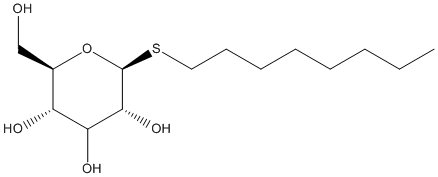Octylthioglucoside
General
Type : Analogue of substrate || Detergent || Carbohydrate || Glycoside
Chemical_Nomenclature : (2R,3S,5R,6S)-2-(hydroxymethyl)-6-octylsulfanyloxane-3,4,5-triol
Canonical SMILES : CCCCCCCCSC1C(C(C(C(O1)CO)O)O)O
InChI : InChI=1S\/C14H28O5S\/c1-2-3-4-5-6-7-8-20-14-13(18)12(17)11(16)10(9-15)19-14\/h10-18H,2-9H2,1H3\/t10-,11-,12?,13-,14+\/m1\/s1
InChIKey : CGVLVOOFCGWBCS-DUJLVANISA-N
Other name(s) : SOG, NSC 628324, AC1MHZDA, (2R,3S,5R,6S)-2-(hydroxymethyl)-6-octylsulfanyloxane-3,4,5-triol\; Beta-D-Glucopyranoside, octyl 1-thio-, n-octyl-beta-D-thioglucopyranoside, n-octyl-beta-D-thioglucoside, octyl beta-D-thioglucoside, octyl-thioglucoside

Target
Families : A85-Mycolyl-transferase
References (3)
| Title : Antigen 85C inhibition restricts Mycobacterium tuberculosis growth through disruption of cord factor biosynthesis - Warrier_2012_Antimicrob.Agents.Chemother_56_1735 |
| Author(s) : Warrier T , Tropis M , Werngren J , Diehl A , Gengenbacher M , Schlegel B , Schade M , Oschkinat H , Daffe M , Hoffner S , Eddine AN , Kaufmann SH |
| Ref : Antimicrobial Agents & Chemotherapy , 56 :1735 , 2012 |
| Abstract : Warrier_2012_Antimicrob.Agents.Chemother_56_1735 |
| ESTHER : Warrier_2012_Antimicrob.Agents.Chemother_56_1735 |
| PubMedSearch : Warrier_2012_Antimicrob.Agents.Chemother_56_1735 |
| PubMedID: 22290959 |
| Title : Mycobacterium tuberculosis antigen 85A and 85C structures confirm binding orientation and conserved substrate specificity - Ronning_2004_J.Biol.Chem_279_36771 |
| Author(s) : Ronning DR , Vissa V , Besra GS , Belisle JT , Sacchettini JC |
| Ref : Journal of Biological Chemistry , 279 :36771 , 2004 |
| Abstract : Ronning_2004_J.Biol.Chem_279_36771 |
| ESTHER : Ronning_2004_J.Biol.Chem_279_36771 |
| PubMedSearch : Ronning_2004_J.Biol.Chem_279_36771 |
| PubMedID: 15192106 |
| Gene_locus related to this paper: myctu-a85a , myctu-a85c |
| Title : Characteristics of n-octyl beta-D-thioglucopyranoside, a new non-ionic detergent useful for membrane biochemistry - Saito_1984_Biochem.J_222_829 |
| Author(s) : Saito S , Tsuchiya T |
| Ref : Biochemical Journal , 222 :829 , 1984 |
| Abstract : Saito_1984_Biochem.J_222_829 |
| ESTHER : Saito_1984_Biochem.J_222_829 |
| PubMedSearch : Saito_1984_Biochem.J_222_829 |
| PubMedID: 6237644 |